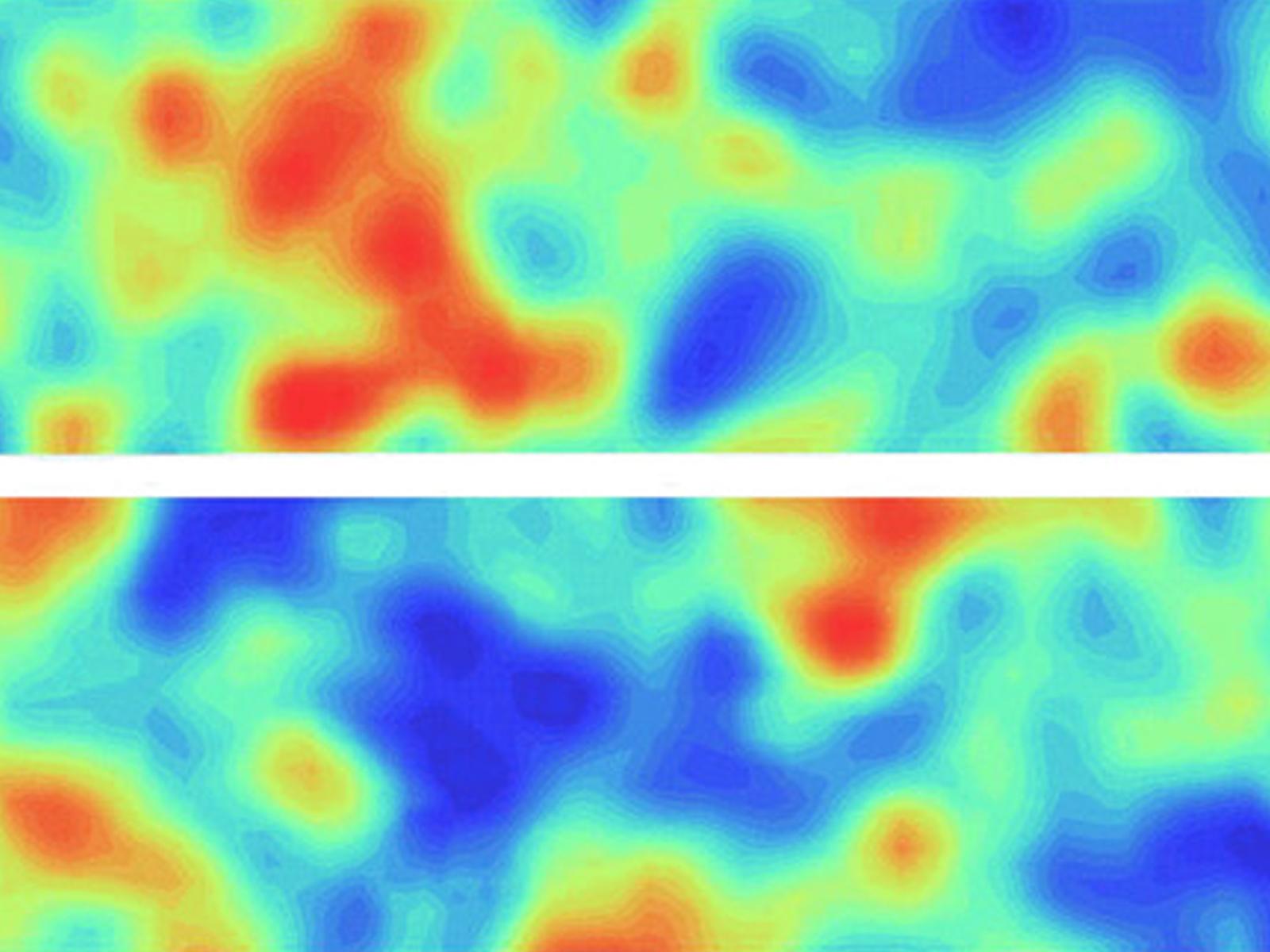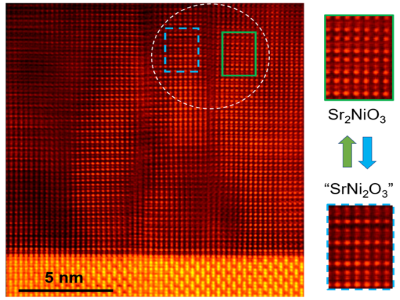Spontaneous Formation of Nickelate Nanocomposite Thin Films
Two different nickelate phases spontaneously form during molecular beam epitaxy deposition

A 3D volume rendering showing regions with greater than 2D Ni2+ (top) and Sr2+ (bottom) concentration maps highlighting where spatially localized Ni and Sr enrichment occurs.
(Image courtesy of Yingge Du and Zhenzhong Yang | Pacific Northwest National Laboratory)
The Science
Perovskite-structured nickelates and their structural variations exhibit intriguing physical and chemical properties. However, there is still much to learn about how to controllably create and stabilize these materials. Researchers found that two complementary phases, Sr2NiO3 and SrNi2O3, are more stable than phase pure SrNiO3 and formed instead of the targeted phase during oxygen-plasma-assisted molecular beam epitaxial film growth. The researchers determined that strain at the interface and the relatively high stability of Ni2+ compared to Ni4+ drive this spontaneous phase segregation.
The Impact
Complex nickelates show great promise for applications including sensing, electrocatalysis, and microelectronics due to the strong tunability of their atomic and electronic structures. This work provides fundamental insights into the diffusion, nucleation, and phase segregation processes that can occur during the epitaxial growth of such materials. This knowledge opens new avenues for phase tuning and exploring emergent phenomena in nickelates.
Summary
Understanding phase stability and phase transitions is central to material synthesis and condensed matter physics. Sr doping in rare-earth nickelates has been extensively investigated recently as an effective strategy to tune their electrocatalytic properties. In addition, the recent discovery of superconductivity in infinitely layered Nd0.8Sr0.2NiO2 has motivated the synthesis of nickelates with higher Sr concentration. Previous research showed that increasing the Sr doping level can induce structural degradation. This work explored whether epitaxial growth could stabilize phase pure SrNiO3 films or, if not, what secondary phase(s) might evolve under practical synthetic conditions. A team of researchers showed that spontaneous phase segregation occurs while targeting pure SrNiO3 thin film fabrication on perovskite oxide substrates. Combined studies revealed that two co-existing phases, Sr2NiO3 and SrNi2O3, form to balance the material’s stoichiometry and stabilize the energetically preferred Ni2+ cation.

The formation of these co-existing phases explains the structural instability of nickelates with high Sr content. The unique, self-assembled nanocomposite structures result from an unusual kind of film nucleation, apparently driven by interfacial strain and the high stability of Ni2+. These materials offer a fascinating testbed for understanding emergent phenomena in nickelates.
PNNL Contact
Yingge Du, Pacific Northwest National Laboratory, Yingge.Du@pnnl.gov
Funding
The film growth and in-situ XPS measurements are supported by U.S. Department of Energy (DOE), Office of Science, Office of Basic Energy Sciences, the Division of Materials Sciences and Engineering under Award #10122. The XRD, STEM/EELS, and APT work is supported by the U.S. DOE, Office of Science, Early Career Research Program under Award #68278. The first principles calculations are supported by the EU H2020-NMBP-TO-IND-2018 project "INTERSECT" (Grant No. 814487). We acknowledge facility support from W. R. Wiley Environmental Molecular Sciences Laboratory, a DOE User Facility sponsored by the Office of Biological and Environmental Research. We thank the Singapore Synchrotron Light Source (SSLS) and Beijing Synchrotron Radiation Facility for providing the facilities support. The SSLS is a National Research Infrastructure under the National Research Foundation, Singapore.
Published: March 5, 2021
L. Wang, Z. Yang, X. Yin, S. D. Taylor, X. He, C. S. Tang, M. E. Bowden, J. Zhao, J. Wang, J. Liu, D. E. Perea, L. Wangoh, A. T. S. Wee, H. Zhou, S. A. Chambers*, Y. Du*, “Spontaneous Phase Segregation of Sr2NiO3 and SrNi2O3 during SrNiO3 Heteroepitaxy,” Sci. Adv., 7(10), eabe2866, (2021).